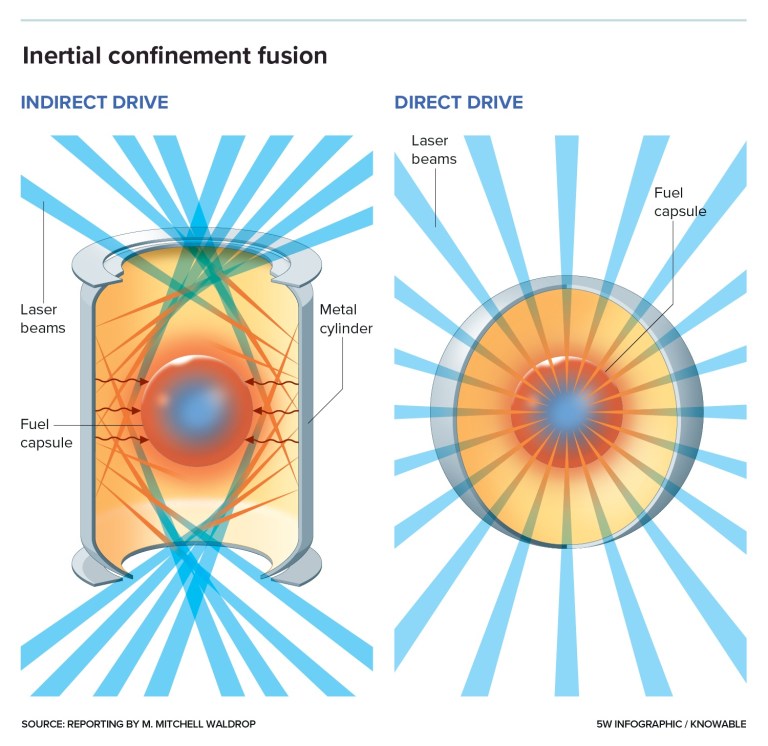
Posted on 11/17/2023 11:35:43 AM PST by Red Badger
Scientists have been chasing the dream of harnessing the reactions that power the Sun since the dawn of the atomic era. Interest, and investment, in the carbon-free energy source is heating up.
~~~~~~~~~~~~~~~~~~~~~~~~~~~~~~~~~~~~~~~~~~~~~~~~~~~~~~~~
For the better part of a century now, astronomers and physicists have known that a process called thermonuclear fusion has kept the Sun and the stars shining for millions or even billions of years. And ever since that discovery, they’ve dreamed of bringing that energy source down to Earth and using it to power the modern world.
It’s a dream that’s only become more compelling today, in the age of escalating climate change. Harnessing thermonuclear fusion and feeding it into the world’s electric grids could help make all our carbon dioxide-spewing coal- and gas-fired plants a distant memory. Fusion power plants could offer zero-carbon electricity that flows day and night, with no worries about wind or weather — and without the drawbacks of today’s nuclear fission plants, such as potentially catastrophic meltdowns and radioactive waste that has to be isolated for thousands of centuries.
In fact, fusion is the exact opposite of fission: Instead of splitting heavy elements such as uranium into lighter atoms, fusion generates energy by merging various isotopes of light elements such as hydrogen into heavier atoms.
To make this dream a reality, fusion scientists must ignite fusion here on the ground — but without access to the crushing levels of gravity that accomplish this feat at the core of the Sun. Doing it on Earth means putting those light isotopes into a reactor and finding a way to heat them to hundreds of millions of degrees centigrade — turning them into an ionized “plasma” akin to the insides of a lightning bolt, only hotter and harder to control. And it means finding a way to control that lightning, usually with some kind of magnetic field that will grab the plasma and hold on tight while it writhes, twists and tries to escape like a living thing.
Both challenges are daunting, to say the least. It was only in late 2022, in fact, that a multibillion-dollar fusion experiment in California finally got a tiny isotope sample to put out more thermonuclear energy than went in to ignite it. And that event, which lasted only about one-tenth of a nanosecond, had to be triggered by the combined output of 192 of the world’s most powerful lasers.
~~~~~~~~~~~~~~~~~~~~~~~~~~~~~~~~~~~~~~~~~~~~~~~~~~~~~~~~~~~~~

This approach to fusion starts with a tiny solid target filled with deuterium-tritium fuel that gets hit from every side with intense pulses of energy. This can be done indirectly (left) by surrounding the target with a small metal cylinder. Lasers strike the insides of the cylinder, generating X-rays that heat the fuel pellet. The laser beams can also heat the target directly (right). Either way, the fuel pellet implodes, and the resulting energy release quickly blows the target apart. The indirect approach was used by the National Ignition Facility in the heralded “break even” experiments that produced more energy than the lasers delivered. But this approach to fusion is probably many decades from being a practical way to generate electricity.
~~~~~~~~~~~~~~~~~~~~~~~~~~~~~~~~~~~~~~~~~~~~~~~~~~~~~~~~~~
Today, though, the fusion world is awash in plans for much more practical machines. Novel technologies such as high-temperature superconductors are promising to make fusion reactors smaller, simpler, cheaper and more efficient than once seemed possible. And better still, all those decades of slow, dogged progress seem to have passed a tipping point, with fusion researchers now experienced enough to design plasma experiments that work pretty much as predicted.
“There is a coming of age of technological capability that now matches up with the challenge of this quest,” says Michl Binderbauer, CEO of the fusion firm TAE Technologies in Southern California.
Indeed, more than 40 commercial fusion firms have been launched since TAE became the first in 1998 — most of them in the past five years, and many with a power-reactor design that they hope to have operating in the next decade or so. “‘I keep thinking that, oh sure, we’ve reached our peak,” says Andrew Holland, who maintains a running count as CEO of the Fusion Industry Association, an advocacy group he founded in 2018 in Washington, DC. “But no, we keep seeing more and more companies come in with different ideas.”
None of this has gone unnoticed by private investment firms, which have backed the fusion startups with some $6 billion and counting. This combination of new technology and private money creates a happy synergy, says Jonathan Menard, head of research at the Department of Energy’s Princeton Plasma Physics Laboratory in New Jersey, and not a participant in any of the fusion firms.
Compared with the public sector, companies generally have more resources for trying new things, says Menard. “Some will work, some won’t. Some might be somewhere in between,” he says. “But we’re going to find out, and that’s good.”
Granted, there’s ample reason for caution — starting with the fact that none of these firms has so far shown that it can generate net fusion energy even briefly, much less ramp up to a commercial-scale machine within a decade. “Many of the companies are promising things on timescales that generally we view as unlikely,” Menard says.
But then, he adds, “we’d be happy to be proven wrong.”
With more than 40 companies trying to do just that, we’ll know soon enough if one or more of them succeeds. In the meantime, to give a sense of the possibilities, here is an overview of the challenges that every fusion reactor has to overcome, and a look at some of the best-funded and best-developed designs for meeting those challenges.
Prerequisites for fusion
The first challenge for any fusion device is to light the fire, so to speak: It has to take whatever mix of isotopes it’s using as fuel, and get the nuclei to touch, fuse and release all that beautiful energy.
This means literally “touch”: Fusion is a contact sport, and the reaction won’t even begin until the nuclei hit head on. What makes this tricky is that every atomic nucleus contains positively charged protons and — Physics 101 — positive charges electrically repel each other. So the only way to overcome that repulsion is to get the nuclei moving so fast that they crash and fuse before they’re deflected.
This need for speed requires a plasma temperature of at least 100 million degrees C. And that’s just for a fuel mix of deuterium and tritium, the two heavy isotopes of hydrogen. Other isotope mixes would have to get much hotter — which is why “DT” is still the fuel of choice in most reactor designs.
~~~~~~~~~~~~~~~~~~~~~~~~~~~~~~~~~~~~~~~~~~~~~~~~~~~~
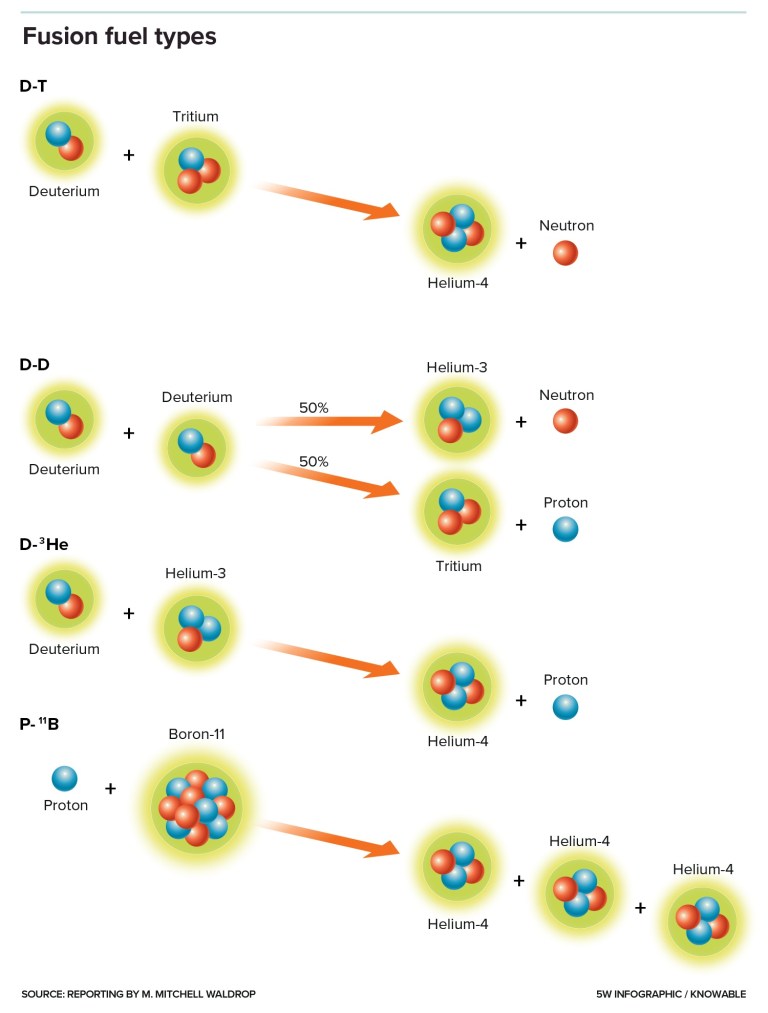
In fusion reactors, light isotopes fuse to form heavier ones and release energy in the process. Shown here are four examples of reactor fuels. The first, D-T, combines two heavy forms of hydrogen (deuterium and tritium). This mix is most common because it begins to fuse at the lowest temperature, but tritium is radioactive, and the generated neutrons can make the reactor radioactive. A reaction between two deuterium nuclei (D-D) proceeds more slowly and requires high temperatures. Using a deuterium-helium-3 mix is also less common, in part because helium-3 is rare and expensive. Perhaps the most tantalizing is a mix of protons and boron-11 (P-11B). Both isotopes are non-radioactive and abundant, while their fusion products are stable and easy to capture for energy extraction. The challenge will be to get the mix to fusion temperatures of more than 1 billion degrees Celsius.
~~~~~~~~~~~~~~~~~~~~~~~~~~~~~~~~~~~~~~~~~~~~~~~~~~~~~~~~~~~
But whatever the fuel, the quest to reach fusion temperatures generally comes down to a race between researchers’ efforts to pump in energy with an external source such as microwaves, or high-energy beams of neutral atoms, and plasma ions’ attempts to radiate that energy away as fast as they receive it.
The ultimate goal is to get the plasma past the temperature of “ignition,” which is when fusion reactions will start to generate enough internal energy to make up for that radiating away of energy — and power a city or two besides.
But this just leads to the second challenge: Once the fire is lit, any practical reactor will have to keep it lit — as in, confine these superheated nuclei so that they’re close enough to maintain a reasonable rate of collisions for long enough to produce a useful flow of power.
In most reactors, this means protecting the plasma inside an airtight chamber, since stray air molecules would cool down the plasma and quench the reaction. But it also means holding the plasma away from the chamber walls, which are so much colder than the plasma that the slightest touch will also kill the reaction. The problem is, if you try to hold the plasma away from the walls with a non-physical barrier, such as a strong magnetic field, the flow of ions will quickly get distorted and rendered useless by currents and fields within the plasma.
Unless, that is, you’ve shaped the field with a great deal of care and cleverness — which is why the various confinement schemes account for some of the most dramatic differences between reactor designs.
Finally, practical reactors will have to include some way of extracting the fusion energy and turning it into a steady flow of electricity. Although there has never been any shortage of ideas for this last challenge, the details depend critically on which fuel mix the reactor uses.
With deuterium-tritium fuel, for example, the reaction produces most of its energy in the form of high-speed particles called neutrons, which can’t be confined with a magnetic field because they don’t have a charge. This lack of an electric charge allows the neutrons to fly not only through the magnetic fields but also through the reactor walls. So the plasma chamber will have to be surrounded by a “blanket”: a thick layer of some heavy material like lead or steel that will absorb the neutrons and turn their energy into heat. The heat can then be used to boil water and generate electricity via the same kind of steam turbines used in conventional power plants.
~~~~~~~~~~~~~~~~~~~~~~~~~~~~~~~~~~~~~~~~~~~~~~~~~~~~~~~~~~~~
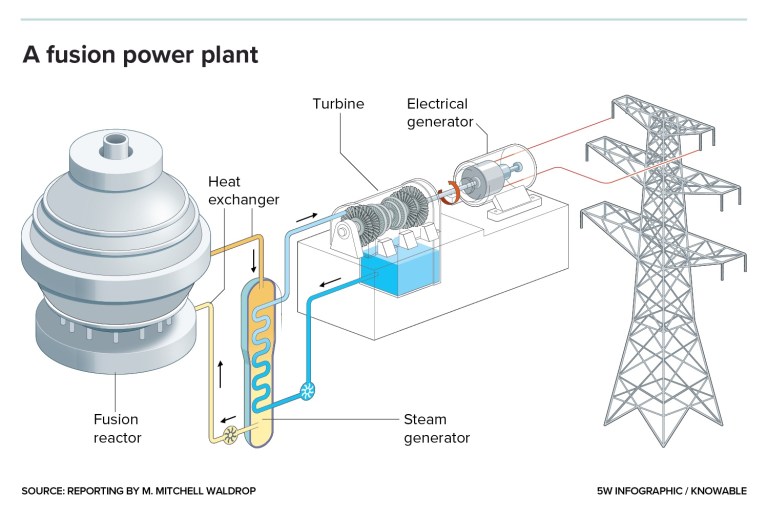
A fusion power plant could use one of several different reactor types, but it will turn fusion energy into electricity the same way that fossil-fuel power plants or nuclear-fission reactors do: Heat from the energy source will boil water to make steam, the steam will flow through a steam turbine, and the turbine will turn an electric generator to send power into the grid.
~~~~~~~~~~~~~~~~~~~~~~~~~~~~~~~~~~~~~~~~~~~~~~~~~~~~~~~~~
Many DT reactor designs also call for including some lithium in the blanket material, so that the neutrons will react with that element to produce new tritium nuclei. This step is critical: Since each DT fusion event consumes one tritium nucleus, and since this isotope is radioactive and doesn’t exist in nature, the reactor would soon run out of fuel if it didn’t exploit this opportunity to replenish it.
The complexities of DT fuel are cumbersome enough that some of the more audacious fusion startups have opted for alternative fuel mixes. Binderbauer’s TAE, for example, is aiming for what many consider the ultimate fusion fuel: a mix of protons and boron-11. Not only are both ingredients stable, nontoxic and abundant, their sole reaction product is a trio of positively charged helium-4 nuclei whose energy is easily captured with magnetic fields, with no need for a blanket.
But alternative fuels present different challenges, such as the fact that TAE will have to get its proton-boron-11 mix to up fusion temperatures of at least a billion degrees Celsius, roughly 10 times higher than the DT threshold.
A plasma donut
The basics of these three challenges — igniting the plasma, sustaining the reaction, and harvesting the energy — were clear from the earliest days of fusion energy research. And by the 1950s, innovators in the field had begun to come up with any number of schemes for solving them — most of which fell by the wayside after 1968, when Soviet physicists went public with a design they called the tokamak.
Like several of the earlier reactor concepts, tokamaks featured a plasma chamber something like a hollow donut — a shape that allowed the ions to circulate endlessly without hitting anything — and controlled the plasma ions with magnetic fields generated by current-carrying coils wrapped around the outside of the donut.
But tokamaks also featured a new set of coils that caused an electric current to go looping around and around the donut right through the plasma, like a circular lightning bolt. This current gave the magnetic fields a subtle twist that went a surprisingly long way toward stabilizing the plasma. And while the first of these machines still couldn’t get anywhere close to the temperatures and confinement times a power reactor would need, the results were so much better than anything seen before that the fusion world pretty much switched to tokamaks en masse.
~~~~~~~~~~~~~~~~~~~~~~~~~~~~~~~~~~~~~~~~~~~~~~~~~~~~~~~~~~~~
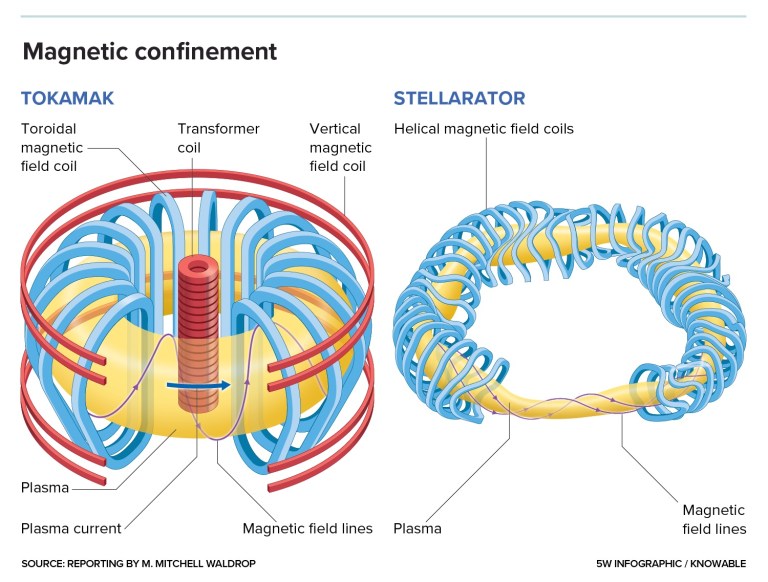
Tokamak reactors (left) and related designs known as stellarator reactors (right) both confine the superhot plasma (yellow) with magnetic fields (purple) that are generated by electromagnetic coils (blue and red). With tokamaks, the most common type of reactor, these coils also start an electric current flowing through the plasma, which helps keep the reaction stable. The stellarator design likewise confines the plasma inside an airtight donut, but eliminates the need for a donut-circling current by controlling the plasma with a much more complex set of external coils (blue).
~~~~~~~~~~~~~~~~~~~~~~~~~~~~~~~~~~~~~~~~~~~~~~~~~~~~~~~~~~~~~~
Since then, more than 200 tokamaks of various designs have been built worldwide, and physicists have learned so much about tokamak plasmas that they can confidently predict the performance of future machines. That confidence is why an international consortium of funding agencies has been willing to commit more than $20 billion to build ITER (Latin for “the way”): a tokamak scaled up to the size of a 10-story building. Under construction in southern France since 2010, ITER is expected to start experiments with deuterium-tritium fuel in 2035. And when it does, physicists are quite sure that ITER will be able to hold and study burning fusion plasmas for minutes at a time, providing a unique trove of data that will hopefully be useful in the construction of power reactors.
But ITER was also designed as a research machine with a lot more instrumentation and versatility than a working power reactor would ever need — which is why two of today’s best-funded fusion startups are racing to develop tokamak reactors that would be a lot smaller, simpler and cheaper.
First out of the gate was Tokamak Energy, a UK firm founded in 2009. The company has received some $250 million in venture capital over the years to develop a reactor based on “spherical tokamaks” — a particularly compact variation that looks more like a cored apple than a donut.
But coming up fast is Commonwealth Fusion Systems in Massachusetts, an MIT spinoff that wasn’t even launched until 2018. Although Commonwealth’s tokamak design uses a more conventional donut configuration, access to MIT’s extensive fundraising network has already brought the company nearly $2 billion.
Both firms are among the first to generate their magnetic fields with cables made of high-temperature superconductors (HTS). Discovered in the 1980s but only recently available in cable form, these materials can carry an electrical current without resistance even at a relatively torrid 77 Kelvins, or -196 degrees Celsius, warm enough to be achieved with liquid nitrogen or helium gas. This makes HTS cables much easier and cheaper to cool than the ones that ITER will use, since those will be made of conventional superconductors that need to be bathed in liquid helium at 4 Kelvins.
But more than that, HTS cables can generate much stronger magnetic fields in a much smaller space than their low-temperature counterparts — which means that both companies have been able to shrink their power plant designs to a fraction of the size of ITER.
As dominant as tokamaks have been, however, most of today’s fusion startups are not using that design. They’re reviving older alternatives that could be smaller, simpler and cheaper than tokamaks, if someone could make them work.
Plasma vortices
Prime examples of these revived designs are fusion reactors based on smoke-ring-like plasma vortices known as the field-reversed configuration (FRC). Resembling a fat, hollow cigar that spins on its axis like a gyroscope, an FRC vortex holds itself together with its own internal currents and magnetic fields — which means there’s no need for an FRC reactor to keep its ions endlessly circulating around a donut-shaped plasma chamber. In principle, at least, the vortex will happily stay put inside a straight cylindrical chamber, requiring only a light-touch external field to hold it steady. This means that an FRC-based reactor could ditch most of those pricey, power-hungry external field coils, making it smaller, simpler and cheaper than a tokamak or almost anything else.
~~~~~~~~~~~~~~~~~~~~~~~~~~~~~~~~~~~~~~~~~~~~~~~~~~~~~~~~~~~~~~~~~~~~
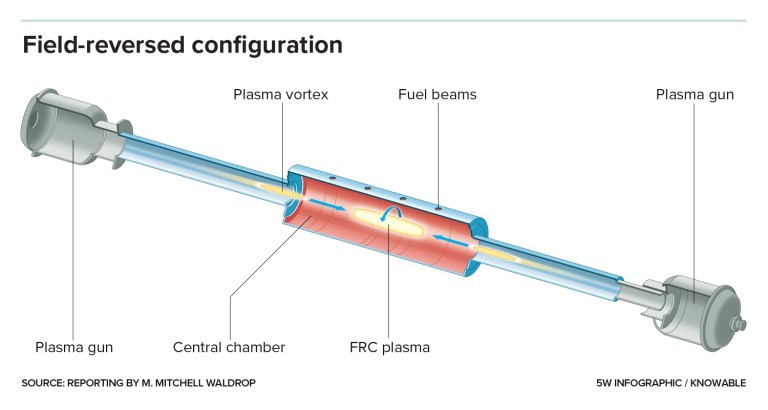
Shown here is a linear reactor concept based on an especially stable plasma vortex that is held together with its own internal currents and magnetic fields. Called the field-reversed configuration (FRC), it is formed from the merger of two simpler vortices that are fired from each end of the reaction chamber by plasma guns. Beams of fresh fuel coming in from the side keep the FRC hot and spinning briskly.
~~~~~~~~~~~~~~~~~~~~~~~~~~~~~~~~~~~~~~~~~~~~~~~~~~~~~~~~~~~~~~~~~~~~~~
In practice, unfortunately, the first experiments with these whirling plasma cigars back in the 1960s found that they always seemed to tumble out of control within a few hundred microseconds, which is why the approach was mostly pushed aside in the tokamak era.
Yet the basic simplicity of an FRC reactor never fully lost its appeal. Nor did the fact that FRCs could potentially be driven to extreme plasma temperatures without flying apart — which is why TAE chose the FRC approach in 1998, when the company started on its quest to exploit the 1-billion-degree proton-boron-11 reaction.
Binderbauer and his TAE cofounder, the late physicist Norman Rostoker, had come up with a scheme to stabilize and sustain the FRC vortex indefinitely: Just fire in beams of fresh fuel along the vortex’s outer edges to keep the plasma hot and the spin rate high.
It worked. By the mid-2010s, the TAE team had shown that those particle beams coming in from the side would, indeed, keep the FRC spinning and stable for as long as the beam injectors had power — just under 10 milliseconds with the lab’s stored-energy supply, but as long as they want (presumably) once they can siphon a bit of spare energy from a proton-boron-11-burning reactor. And by 2022, they had shown that their FRCs could retain that stability well above 70 million degrees C.
With the planned 2025 completion of its next machine, the 30-meter-long Copernicus, TAE is hoping to actually reach burn conditions above 100 million degrees (albeit using plain hydrogen as a stand-in). This milestone should give the TAE team essential data for designing their DaVinci machine: a reactor prototype that will (they hope) start feeding p-B11-generated electricity into the grid by the early 2030s.
Plasma in a can
Meanwhile, General Fusion of Vancouver, Canada, is partnering with the UK Atomic Energy Authority to construct a demonstration reactor for perhaps the strangest concept of them all, a 21st-century revival of magnetized target fusion. This 1970s-era concept amounts to firing a plasma vortex into a metal can, then crushing the can. Do that fast enough and the trapped plasma will be compressed and heated to fusion conditions. Do it often enough and a more or less continuous string of fusion energy pulses back out, and you’ll have a power reactor.
In General Fusion’s current concept, the metal can will be replaced by a molten lead-lithium mix that’s held by centrifugal force against the sides of a cylindrical container spinning at 400 RPM. At the start of each reactor cycle, a downward-pointing plasma gun will inject a vortex of ionized deuterium-tritium fuel — the “magnetized target” — which will briefly turn the whirling, metal-lined container into a miniature spherical tokamak. Next, a forest of compressed-air pistons arrayed around the container’s outside will push the lead-lithium mix into the vortex, crushing it from a diameter of three meters down to 30 centimeters within about five milliseconds, and raising the deuterium-tritium to fusion temperatures.
~~~~~~~~~~~~~~~~~~~~~~~~~~~~~~~~~~~~~~~~~~~~~~~~~~~~~~~~~~~~~~~~~~~~~
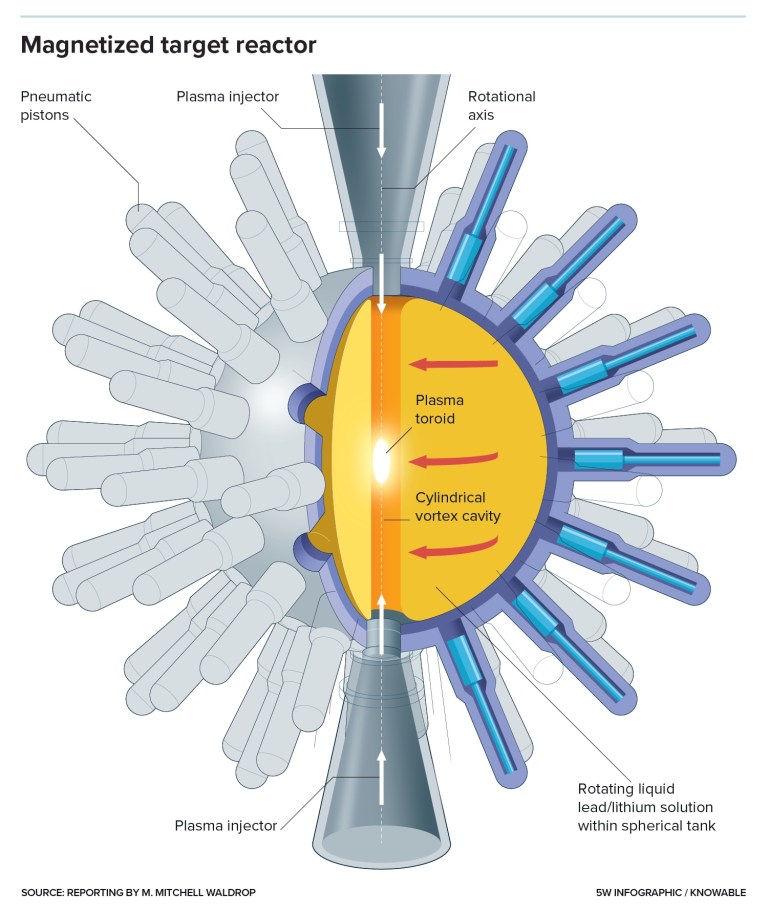
Magnetized target fusion is the 1970s-era name for an approach that amounts to firing a plasma vortex into a metal can, then crushing the can. Shown here is a modern version in which the metal can is replaced by a molten lead-lithium mix that’s held against the sides of a spinning container by centrifugal force. Plasma guns fire vortices of deuterium-tritium plasma into the container’s hollow interior while pistons arrayed around the container’s outside push the lead-lithium mix inwards, crushing the plasma and igniting fusion. The blast pushes the molten lead-lithium mix back out and resets the system.
~~~~~~~~~~~~~~~~~~~~~~~~~~~~~~~~~~~~~~~~~~~~~~~~~~~~~~~~~~~~~~~~~~~~~~
The resulting blast will then strike the molten lead-lithium mix, pushing it back out to the rotating cylinder walls and resetting the system for the next cycle — which will start about a second later. Meanwhile, on a much slower timescale, pumps will steadily circulate the molten metal to the outside so that heat exchangers can harvest the fusion energy it’s absorbed, and other systems can scavenge the tritium generated from neutron-lithium interactions.
All these moving parts require some intricate choreography, but if everything works the way the simulations suggest, the company hopes to build a full-scale, deuterium-tritium-burning power plant by the 2030s.
It’s anybody’s guess when (or if) the particular reactor concepts mentioned here will result in real commercial power plants — or whether the first to market will be one of the many alternative reactor designs being developed by the other 40-plus fusion firms.
But then, few if any of these firms see the quest for fusion power as either a horse race or a zero-sum game. Many of them have described their rivalries as fierce, but basically friendly — mainly because, in a world that’s desperate for any form of carbon-free energy, there’s plenty of room for multiple fusion reactor types to be a commercial success.
“I will say my idea is better than their idea. But if you ask them, they will probably tell you that their idea is better than my idea,” says physicist Michel Laberge, General Fusion’s founder and chief scientist. “Most of these guys are serious researchers, and there’s no fundamental flaw in their schemes.” The actual chance of success, he says, is improved by having more possibilities. “And we do need fusion on this planet, badly.”
This article originally appeared in Knowable Magazine, a nonprofit publication dedicated to making scientific knowledge accessible to all. Sign up for Knowable Magazine’s newsletter.
Best you stick to facts and stay away from internet mind reading.
///////
So did you listen to their freaking presentation?
“I can be swayed by the charlaton ceo’s at fusion companies Helion and Massachusetts Commonwealth Systems.”
Helion doesn’t even have a working prototype.
Commonwealth Fusion Systems INTENDS to have a plant in the early 30’s.
Neither company has proven technology.
Neither company has proven technology.
/////
agree. but its not the product that is generating their confidence. its the the iterative process that generates their confidence.
There is one thing that I have heard in the last year that I have never heard before.
I think the guy who runs a Mars society Dr. Robert Zubrin mentioned it in a recent book. (nuclear is topical for that crowd because they’re going to need some kind power that’s denser than solar for mars.)
Zubrin mentioned that the onerous regulations on nuclear developed after 3 mile island —came from the sierra club. At that time the sierra club mentioned that their aim was not to regulate nuclear power but to kill it. why? the sierra club was and is against developement. they want fewer people and more nature. they feared that nuclear power would be so successful that it would wildly promote development and advance civilization.
the proof texts on that are in zubrin’s book. I just saw an interview where he discussed it.
“Zubrin mentioned that the onerous regulations on nuclear developed after 3 mile island —came from the sierra club. “
The regulations did not come from the Sierra Club. They came from engineering technical and human factors review of the accident. The regulations were not onerous.
“its the the iterative process that generates their confidence.”
UF qb hurt so I took some time to view the video. I heard nothing technical in the first 20 minutes.
Definitely no iterative process. Commonwealth, with no proven tech, is building a 100 Mw unit! Helion, with no proven tech, is saying they are “skipping steps”.
So you go for the 20 years in the future (and maybe always will be 20 years in the future) ITER promises as being more believeable. That is the current conventional wisdom.
That was a long conversation those people had on stage. I get your impatience.
I heard nothing technical in the first 20 minutes.
//////
It was not a technical conversation because the audience was non technical.
The regulations did not come from the Sierra Club. They came from engineering technical and human factors review of the accident. The regulations were not onerous.
/////////
so why did the US nuclear power industry die as competitive entity in the international market place? Heck I’ve read that the Koreans can produce nuclear power for .03@kwh. might be a lie but the US is not a major player in nuclear power business except in the USA and even here—they stopped making nuclear reactors decades ago. Oh yes there is one nuclear power plant that was developed down south somewhere—maybe georgia but that was the first one in a long time.
“So you go for the 20 years in the future (and maybe always will be 20 years in the future)”
Stop with the false projections and stick with what I post.
Commonwealth says they will have a 100 Mw plant operating in 2025. Do you believe that?
Lots of reasons. Nuclear plants require huge upfront investments. Money, staff, training etc. Along came cheap gas turbine units. All a utility had to do was sign the contract. No mess, no fuss. Also, gas plants could be added as smaller units to be added quickly as needed.
Remember the high interest rates in the 80’s? A real killer!
“Heck I’ve read that the Koreans can produce nuclear power for .03@kwh.”
That would be only the operating costs. Does not include cost to build the plant.
I worked at two of the plants that my company sold to Korea.
“Zubrin mentioned that the onerous regulations on nuclear developed after 3 mile island —came from the sierra club. “
Just for fun and because I enjoy research on the fly. I checked.
There are three questions.
Did zubrin say it.
Was the sierra club anti growth? (and for that matter anti human.)
Did the sierra club influence nuclear regulations.
......
Did zubrin say it.
Yes, here’s a tweet in which he says “The Sierra Club original statement in opposition to nuclear power frankly admitted they were opposing it because it could lead to “excessive economic growth.”
https://twitter.com/robert_zubrin/status/1394005943101181953
////////////////
Was the sierra club anti growth? (and for that matter anti human.)
yes.
Here’s an article in Foreign Affairs entitled “who killed nuclear energy and how to revive it.
https://americanaffairsjournal.org/2022/05/who-killed-nuclear-energy-and-how-to-revive-it/
“For our purposes, it must be noted that Erlich’s book {the population bomb} was written at the request of David Brower, president of the Sierra Club. According to Erlich and his wife, The Population Bomb was “written in response to a request that Paul summarize arguments he had been making in the media that the population issue should be taken up by the growing environmental movement “
The article goes on to show how the sierra club and the environmentalists tarred nuclear power as a way to limit growth in the usa. that is, their eugenic roots got bad name —so they segwayed to limiting growth. What you’ll notice in tthe article is that the environmentalists were heavily into shaping policy before any policy prescriptions were even written. Much the same thing happens today.
///////////////
Did the sierra club influence nuclear regulations?
I asked bing’s ai this question. their answer was
“After the Three Mile Island accident in 1979, the Sierra Club advocated for greater protection for public health and safety. They called for the appointment of a special citizens’ advisory group to advise the president, Congress, and the Nuclear Regulatory Commission (NRC) on the implementation of reforms recommended by the Kemeny Commission and such additional reforms as may be recommended by other studies now underway of the events leading to the Three Mile Island accident. The Sierra Club also advocated for the making of appointments to this advisory group, to the Nuclear Regulatory Commission, and to staff positions in the NRC from a pool of individuals not committed by past experience to the nuclear industry. Such appointments should have a demonstrated commitment to public health and safety.”
Their references for this answer were sierraclub.org and the nrc.gov.
So the Sierra Club recommended that the nuclear regulations follow the recommendations of the Kemeny commission.
Ok I asked AI as to whether the recommendations of the Kemeny Commission were used to create nuclear regulations following three mile island.
The answer:
ChatGPT
“The Kemeny Commission, officially known as the President’s Commission on the Accident at Three Mile Island, was established to investigate the Three Mile Island nuclear accident in 1979. The commission’s report included a number of recommendations aimed at improving nuclear plant safety and regulatory oversight. These recommendations indeed influenced subsequent regulations in the nuclear power industry.”
“The U.S. Nuclear Regulatory Commission (NRC) and other regulatory bodies used the findings and recommendations of the Kemeny Commission to enhance safety protocols, improve emergency preparedness, strengthen regulatory oversight, and increase the involvement of public and independent experts in decision-making processes regarding nuclear power. The Kemeny Commission’s report played a significant role in shaping the modern regulatory framework for the nuclear power industry in the United States.”
Does this actually mean anything?
the answer to that question lies with competitors to the USA in the nuclear power industry. What role did the regulations of the nuclear power industries in countries like china, russia south korea and france have to do with their success?
I don’t have an answer to that. Maybe you can color that in.
the foreign affairs article above has suggested changes.
The president of helion described the advice of his advisors in college during the 1990s. He was interested in nuclear power but his advisors said that was dead end field. He went into some kind of IT and at some point realized about 2010 the implications of what he was doing for fusion power and then switched back into nuclear power.
These days nuclear power for both fission and fusion is far more exciting. The excitement in the field harkens back to the 1960’s.
Of course it could all be smoke and mirrors. We’ll see
Commonwealth says they will have a 100 Mw plant operating in 2025. Do you believe that?
......
well if you believe that fusion power is 20 years away and always will be—which is the conventional wisdom for the last 70 years—then no.
but commonwealth is not alone.
as well, Helion has signed a contract with microsoft to provide fusion powered electricity in 2028. there is a wall st journal article about that. (google wall st journal helion, microsoft contract)
now think about that.
proof is in the pudding of course. but you have to say that these guys do have their considerable reputations on the line. and they are competitive. and they don’t sound like goofs. why would they otherwise stick their necks out to make such bold predictions? these guys are no less engineers than you. that means they’re looking at something completely different than you.
What also makes it believable is that one or the other company is not an outlier. these guys know each other. they go to the same conferences. they’re only two out of many other fusion power companies that have sprung up in the last five years or so. why are there so many fusion company start ups? we’re talking about a technological change on a broad front.
the other thing that makes it believable is that the funding coming into fusion is private capital. Government funding for r&d doesn’t have any required payback time. Private capital is different. Private capital needs a return on investment within 5-10 years—preferably within 5 years.
So people with deep pockets have been convinced that they will get a return on capital in a reasonable amount of time.
So here is a huge group of people with serious skin in the game who are betting that fusion energy is right around the corner.
So, I would say based on the evidence that I’ve seen—fusion power is right around the corner.
Until disproven, I believe these guys.
but that’s just me.
You’re free to say the opposite. that is, until proven otherwise, fusion energy is vaporware.
we are both just speculating.
“Does this actually mean anything?
the answer to that question lies with competitors to the USA in the nuclear power industry. What role did the regulations of the nuclear power industries in countries like china, russia south korea and france have to do with their success?”
Since Korea bought our plant designs and modeled their licensing process on ours you have your answer.
“So the Sierra Club recommended that the nuclear regulations follow the recommendations of the Kemeny commission.”
It was a presidential report and would of course be reviewed for upcoming regulations. The SC recommendation was meaningless in the big picture.
“the other thing that makes it believable is that the funding coming into fusion is private capital.”
It’s GREEN! CFS is mainly funded by Bill Gates. Along with Temasek. Temasek has a great track record. Lost their shirt in FTX.
“the other thing that makes it believable is that the funding coming into fusion is private capital.”
The major donor for Helion is Dustin Moskovitz, founder of Facebook and a big time leftist.
Don’t get me wrong. I am glad these global warming billionaires are funding these efforts but they are not funding expecting a profit.
Dustin invested $20 million on Hillary!
Strange bedfellows. Peter Thiel was first outside investor in Facebook. Peter put $1700 in his Roth IRA. into the company that became PayPal. Now worth $5 billion which becomes tax free!
” I believe these guys.”
-———————Helion————————
You might wish to take those claims with a healthy dose of salt. Diving through past coverage of the fusion upstart reveals the company has made some rather fantastic claims. In a 2018 article, the company claimed it would produce a 50MW reactor by 2021. And in 2014, the company was claiming commercial fusion by 2019.
Helion’s habit of insisting fusion power is almost here led Daniel Jassby, who ran the Princeton Plasma Physics Lab until 1999, to label the company’s tech as voodoo fusion in a 2018 article [PDF].
Jassby defines voodoo fusion energy as “those plasma systems that have never produced any fusion neutrons, but whose promoters make the claim of near-term electric power generation.”
https://www.theregister.com/2023/05/17/microsoft_bet_on_fusion/
Trivia:
How are ChatGPT and Helion related?
Disclaimer: Opinions posted on Free Republic are those of the individual posters and do not necessarily represent the opinion of Free Republic or its management. All materials posted herein are protected by copyright law and the exemption for fair use of copyrighted works.